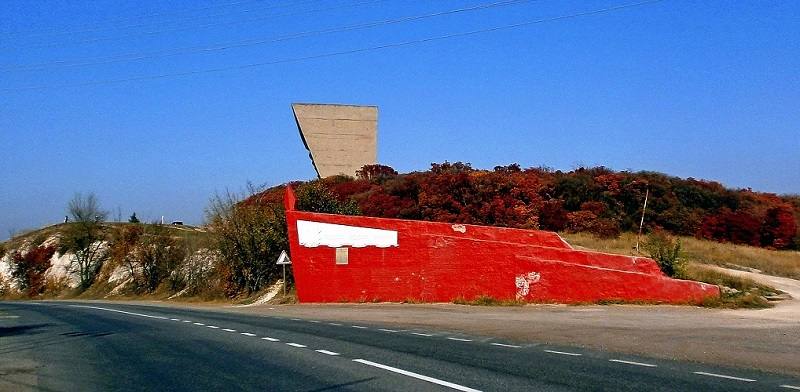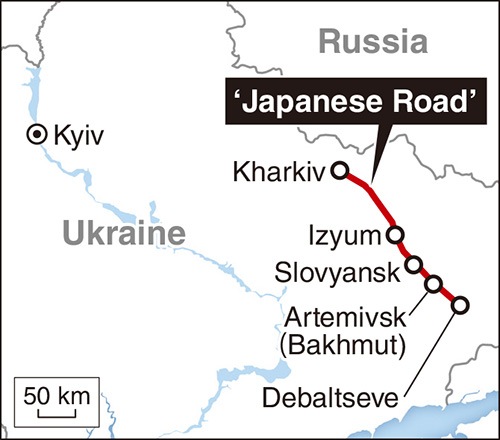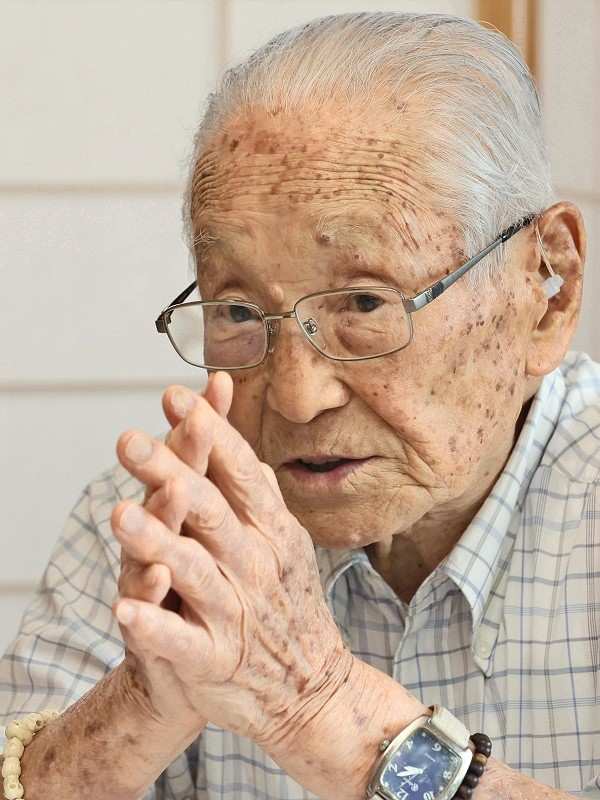Ukraine’s ‘Japanese Road’ serves as reminder of work done by detainees after WWII

Part of “Japanese Road” in Izyum, eastern Ukraine, in October 2019
20:00 JST, August 24, 2022

A map of ‘Japanese Road’
In the eastern part of Ukraine, there is a road said to have been constructed by Japanese detainees after World War II. The road is still in use today, serving as the main route linking the Kharkiv and Donetsk regions, where fierce battles have been fought in the six months since Russia launched its invasion of Ukraine.
“Every time I see or hear news about Ukraine, my heart aches,” said Yasuhiko Ito of Fukuoka, a Japanese man who spent about one year as a detainee in a town along the route, which is said to have been referred to as “Japanese road” by the detainees who constructed it.
Reminiscing about his memories in Ukraine, Ito, 97, expressed hope that the ongoing Russian invasion will end soon.
Ito was a sergeant in the Japanese army during World War II. When the war ended in August 1945, he was in Pyongyang on the Korean Peninsula.
Following the Japanese Army’s disarmament, Ito was transferred by Soviet troops in the summer of 1946 to Vladivostok, in Russia’s Far East.

Yasuhiko Ito speaks about his internment in Ukraine after WWII.
Ito said he recalled hearing Soviet soldiers use the expression “domoi,” which means “to the home country” in Russian.
Assuming he was about to be repatriated, Ito was surprised to be taken to a railroad in the coastal city instead of the port. “You’re small, so go over there,” the 1.57 meter-tall Ito was told, before being ushered into a freight car with about 40 other detainees.
About a month later, Ito arrived in the city of Artemivsk (now Bakhmut in Ukraine’s Donetsk region), which was then part of the Soviet Union.
Ito was forced to do labor such as clearing debris, manufacturing bricks and carrying building materials in the wartorn city, where winter temperatures fall to as low as minus 25 C.
Despite the grueling work, Ito had to survive on a diet of bread and soup.
In later years, he learned that Japanese detainees with sturdier builds had been sent to Siberia. “If I’d gone there, I would have died. [Ukraine] was heaven, compared to Siberia,” he said.
While on the Korean Peninsula, Ito taught himself Russian, which made him useful to the Soviet officers. “This road was built by Japanese detainees,” a Soviet officer told Ito one day when they were on the way to Slovyansk, about 40 kilometers north of Artemivsk.
Ito said he felt welcomed by residents when he was clearing debris and even asked if a local family would adopt him.
After about a year of internment, Ito returned to Japan in 1947. “Some of my friends died. My life there was not easy,” he said, recalling his time in Ukraine. But, he said proudly, “We helped in Ukraine’s recovery process.”
Ito said the images of towns devastated by Russian forces in the ongoing invasion have filled him with anger. “War must not be allowed. It is absolutely wrong,” he said.
According to the Health, Labor and Welfare Ministry, about 5,000 Japanese people were interned in Ukraine after World War II.
About 4,000 were interned in the Kharkiv region, according to a 2013 book titled “Ukraine ni Yokuryusareta Nihonjin” (Japanese interned in Ukraine), compiled by Ukrainian historians and others, based on the testimonies of former detainees.

Andrii Paramonov
Andrii Paramonov, 52, a historian from the Kharkiv region, said road construction was one of the main jobs assigned to Japanese internees.
Paramonov learned about Japanese internees through a project to commemorate the 50th anniversary of the end of World War II while working for a local TV station in 1995.
According to Paramonov, who has collected materials from military archives of the former Soviet Union and other places, “Japanese Road” was a 250-kilometer route connecting Kharkiv and Debaltseve, a city in the eastern part of the Donetsk region.
After World War II, Japanese detainees worked in various towns along the road, including Artemivsk and Izyum. The road was later extended and became part of a highway connecting Kyiv with southern Russia.
Some buildings that Japanese internees worked on still remain along the route.
The road was targeted by Russian troops during the invasion, and its surface is now riddled with holes, said Paramonov.
Russian troops now occupy a large part of the highway, part of which is in such a bad state that ordinary vehicles are not able to travel along it.
“The death rate among Japanese detainees was high and the burial places for some detainees are not known,” Paramonov said. “After this war ends with Ukraine’s victory, I’d like to keep alive the memory of the Japanese detainees.”




